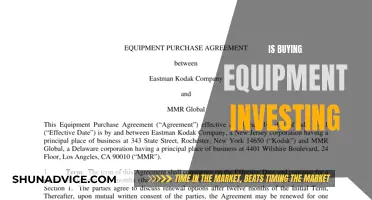
Investment bankers are financial advisors to corporations and governments. During a buy-side M&A deal, they advise companies looking to acquire other companies or assets.
Buy-side investment bankers help companies identify potential sellers with attractive investment opportunities, conduct due diligence, negotiate with the seller, and facilitate the deal's closure. They also advise on valuations and terms for the companies that are attractive to their clients.
Buy-side investment bankers also play a crucial role in helping clients raise capital through various instruments such as equity or debt financing. They may also assist in underwriting for an IPO process, industry research, and advisory services on joint ventures, hostile takeovers, and buyouts.
| Characteristics | Values |
|---|---|
| Company search | Locating companies that fit the buyer's criteria |
| Due diligence | Planning and executing a thorough due diligence process |
| Valuations | Accurate valuation of large, complex companies |
| Negotiations | Negotiating on company valuation, management compensation, deal structure, etc. |
| Initial discussions and analysis | Meeting with potential clients, identifying their goals and preferences, and discussing various potential buyers or sellers |
| M&A strategy development | Developing a comprehensive M&A strategy that outlines the transaction's objectives, financial analysis, valuation metrics, deal structure, and integration planning |
| Post-merger integration | Advising on various aspects, such as organizational structure, management, and operational issues |
| Sell-side investment banking | Advising companies looking to divest companies or assets |
| Buy-side investment banking | Advising companies looking to acquire companies or assets |

Company search
The company search process typically begins with the investment bank understanding the buyer's criteria and strategy. They may suggest alternative criteria, such as a different geography or acquisition size, to broaden the scope of potential targets. The investment bank then creates a long list of companies that match the buyer's criteria and gradually narrows it down to a shortlist of the most suitable candidates. This involves extensive research and analysis to evaluate the potential fit and attractiveness of each company.
Once the shortlist is finalised, the investment bank makes contact with the executive teams of the target companies, gauging their willingness to engage in discussions about a potential sale. This initial outreach is a critical step in the company search process, as it requires tact and discretion to avoid prematurely alerting competitors or the public about the buyer's intentions.
Throughout the company search process, investment bankers utilise their expertise in valuation, due diligence, and deal structuring to assess the suitability of potential targets. They also play a key role in negotiating with target companies and their advisors, helping the buyer navigate the complex landscape of M&A transactions.
The company search phase is just one part of the broader M&A process, which also includes due diligence, valuation, negotiations, and post-merger integration. However, it lays the foundation for a successful transaction by identifying the right targets and initiating the first contact between the buyer and potential sellers.
The Great Housing Grab: Are Investment Firms Buying Up Our Homes?
You may want to see also

Due diligence
- Initiating Due Diligence:
- Information Gathering:
The due diligence team creates a detailed checklist of required documents and sets timelines for their submission. After signing a confidentiality agreement, they request this information from the target company. The scope of documents can vary depending on the industry, size, and nature of the business. However, commonly requested data includes corporate records, IP contracts, stockholder information, litigation history, regulation information, insurance details, leases, and financial statements.
Document Review and Analysis:
The due diligence team meticulously reviews and analyses the provided documents. They assess the target company's financial health, operational assets, legal matters, and strategic position. This phase aims to identify any potential 'red flags' or issues that may impact the deal. If concerns arise, the team may request additional information or clarifications from the target company.
Problem Assessment and Negotiation:
During this stage, the due diligence team evaluates the significance of any problems or discrepancies uncovered. They determine whether the issues warrant abandoning the deal, modifying the offer, or changing the deal's structure or timeline. Meetings may be held between the buyer and target company to address questions and negotiate mutually acceptable solutions.
Final Decision and Purchase Agreement:
After a thorough review, the buyer makes a final assessment of the deal. If the acquisition is deemed a sound investment, the process moves forward. However, if significant challenges are identified, the buyer may request adjustments or even decide to walk away from the deal. The final step involves drafting a purchase agreement, which is sent to the target company for approval, marking the conclusion of the due diligence process.
Benefits of Due Diligence in M&A:
- Risk Mitigation: Buyers can identify and assess financial and legal risks associated with the target company, reducing the likelihood of unexpected issues post-acquisition.
- Informed Decision-Making: By analyzing unique company details, buyers can adjust their expectations and make more informed decisions. This information also strengthens their negotiating position.
- Relationship Building: The due diligence process fosters communication and collaboration between the buyer and target company, laying the foundation for a working relationship.
- Disclosure of Critical Information: Due diligence ensures that important information is disclosed, preventing potential surprises that could affect the buyer's decision-making process.
Types of Due Diligence:
Depending on the nature of the transaction, there are various types of due diligence that may be conducted:
- Tax Due Diligence: Examining the company's tax affairs and ensuring all tax liabilities are up to date, while also assessing the tax implications of the merger.
- Legal Due Diligence: Reviewing legal aspects, including licenses, regulatory issues, contracts, and pending legal liabilities.
- Financial Due Diligence: Analyzing the company's financial performance, statements, and sustainability to ensure accuracy and financial health.
- Operational Due Diligence: Assessing the company's operations and how effectively it converts inputs into outputs, providing insights into future performance.
- Information Technology Due Diligence: Evaluating the company's IT infrastructure, security, and data privacy practices to identify potential threats and understand the IT landscape.
In conclusion, due diligence is a comprehensive and meticulous process that is integral to the success of M&A transactions. It empowers buyers with the information and insights necessary to make strategic decisions, mitigate risks, and ensure a smooth integration process.
Theranos: Why Investors Bought the Lie
You may want to see also

Valuations
Valuation is a key part of the M&A process. Investment bankers put together merger models to analyse the financial profile of two companies that are combining. The primary goal is to determine whether the buyer's earnings per share (EPS) will increase or decrease as a result of the merger. An increase in expected EPS is called accretion, while a decrease is called dilution.
There are several methods for valuing a company in the context of M&A:
- Comparable Company Analysis
- Discounted Cash Flow Analysis
- Accretion/Dilution Analysis
- Precedent Transactions Analysis
- Leveraged Buyout Analysis
The investment banker will refer to a set of questions to evaluate a potential M&A transaction, including:
- Is the target company publicly traded or privately held?
- Is there insider ownership or a sizable public float?
- Who are the potential buyers?
- What is the context of the transaction?
- Is it a privately negotiated sale or an auction?
- What are the market conditions?
- What is the acquisition currency (cash or equity)?
- What historical premiums have been paid for comparable transactions?
The investment banker will also need to understand the different types of M&A transactions, both in terms of the dynamics and the structuring of the deal.
The basic steps to building an M&A model are as follows:
- Determine the pro forma company, which is the combined entity (the acquirer) after the proposed transaction takes place.
- Determine the purchase price and consideration, including any control premium that may be paid.
- Make transaction assumptions about important parameters affecting the deal.
- Build the "Sources & Uses" table, which outlines the flow of funds in the M&A transaction.
- Calculate goodwill, an asset that arises when the acquisition price exceeds the book value of the target company's net tangible assets.
- Make adjustments to the pro forma balance sheet to account for the transaction.
- Perform an accretion/dilution analysis to determine how the target company's financial performance will affect the buyer's EPS.
In addition to the financial analysis, investment bankers also play a role in negotiating the terms of the deal and facilitating the closing process. They may also assist with due diligence, which involves a detailed investigation of the target company's financial, legal, and operational matters.
ARSO's Strategic Play: Navigating Investment Roles in Town of Salem
You may want to see also

Negotiations
The Complexity of M&A Negotiations
Mergers and acquisitions (M&A) negotiations involve a multitude of factors and considerations. It's not just about the financial aspects, but also encompasses a range of strategic and operational elements. Investment bankers need to navigate a labyrinth of negotiations, including company valuation, management compensation, deal structure, and sometimes even labour union discussions. Each of these facets demands a nuanced understanding and tailored strategies.
Investment Bankers as Trusted Advisors
Investment bankers act as trusted advisors to their clients throughout the M&A process. They bring specialist expertise and experience to the negotiating table. Their role is to guide their clients in making well-informed decisions and structuring favourable deals. Bankers analyse the financial health and projections of the target company, assess synergies and potential value creation, and provide insights into industry trends and comparable transactions. This enables them to advise their clients on appropriate valuation metrics and deal terms.
Developing and Delivering Offers
In a buy-side M&A scenario, investment bankers assist their clients in developing and presenting compelling offers. They help buyers identify potential acquisition targets, conduct thorough due diligence, and structure competitive bids. Bankers also play a crucial role in negotiating the purchase agreement, ensuring that the terms and conditions are acceptable to their client. This involves back-and-forth discussions, counter-offers, and revisions to arrive at a mutually agreeable deal structure.
Managing the Emotional Aspects of Negotiations
M&A negotiations can be emotionally charged, particularly when the acquiring company is much larger than the target company. Investment bankers need to be adept at managing these emotions and keeping the negotiations focused and constructive. They must be able to navigate the power dynamics between the parties and ensure that their client's interests are protected. This includes advising on when to compromise and when to stand firm on specific deal points.
Handling Confidentiality and Information Sharing
During the negotiation process, investment bankers facilitate the sharing of sensitive information while maintaining strict confidentiality. They manage the due diligence process, which involves setting up secure data rooms and controlling the flow of information between the parties. This ensures that critical information is disclosed in a controlled and protected manner.
Negotiating on Behalf of Their Clients
Ultimately, investment bankers are advocates for their clients. They represent their client's interests and work to secure the best possible deal terms. This may involve hard bargaining, strategic concessions, and creative solutions to satisfy both parties. Bankers need to be adept at reading the room, understanding the motivations and constraints of each party, and finding common ground that leads to a successful transaction.
The Art of Negotiation
The art of negotiation in M&A goes beyond mere number-crunching. Investment bankers must possess strong communication and relationship-building skills to establish trust and foster productive discussions. They need to be persuasive and influential while maintaining their integrity and ethical standards. The ability to navigate complex human dynamics and steer negotiations towards a favourable outcome is a hallmark of a skilled investment banker.
Australia: Invest Now?
You may want to see also

Post-merger integration
Understand the Challenges and Objectives
- Maintain momentum in the ongoing businesses.
- Maximise and accelerate synergies and value creation.
- Build the organisation and align the cultures to drive the new company forward.
- Use the combined capabilities to advance the company's competitive position.
Define Basic Objectives and Direction
Clearly defining the basic objectives of the integration is crucial. This includes setting clear goals, milestones, and performance metrics to track progress. It is essential to treat PMI as a discrete program, independent of the day-to-day operations of the merged entity.
Senior Leadership Commitment
The support and involvement of senior leaders from both companies are vital to the success of PMI. They must be committed, credible, and highly visible throughout the process. Their role is to provide strategic direction, remove obstacles, and ensure that the integration remains a top priority for the organisation.
Speed and Momentum
Speed is of the essence in PMI. It is crucial to use the period before closing to start designing the future company and preparing to capture value. Aggressively pursuing synergies and maintaining the strength of the current business will help maintain momentum.
Communication
Effective communication is critical to the success of PMI. It is essential to keep all stakeholders informed and aligned throughout the process. This includes regular one-on-one meetings between leaders and managers to ensure everyone is on the same page and can address rumours and miscommunication. Overcommunication is preferable to under-communication during this period.
Address Overlaps and Reduce Workforce
Identifying and addressing overlaps between the two organisations is necessary. Leaders must decide on the direction and determine the optimal workforce required to complete tasks efficiently. This may involve reducing headcount in certain areas to streamline operations and avoid duplication of efforts.
Identify and Develop Leaders
Mergers require strong leadership to navigate the challenges and complexities. It is crucial to identify individuals with integration experience, especially in complex or large mergers, who can provide direction and guidance during the process. Investing in leadership development and building a strong and unified team will contribute to the success of the integration.
Technological Considerations
Access to innovative technology and systems can significantly impact the success of PMI. Leaders must consider the technological needs of the combined organisation, the cost of opting out of current relationships, and the impact on end users. Ensuring compliance with federal and state regulations and addressing potential security risks are also crucial aspects of the technology strategy.
Change Management
Effective change management practices are essential to address post-acquisition challenges. A detailed analysis of the new business, including cultural nuances, is necessary to develop a comprehensive integration plan. Creating a post-merger integration questionnaire can help gather feedback and identify areas that require attention.
Seek Expert Help
Retiring Abroad: Navigating the Tax Maze to Avoid Double Taxation on Investments
You may want to see also







